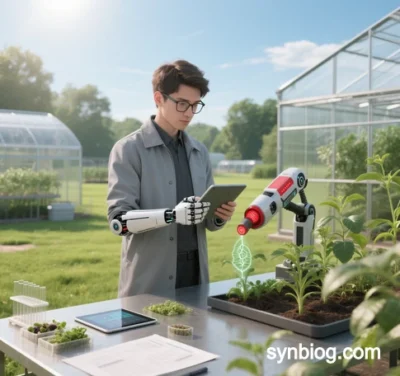
Synthetic Biology: Key Directions in Gene Manipulation
I. Foundational Gene-Editing Technologies
DNA Synthesis & Assembly
- Chemical Synthesis: Solid-phase phosphodiester bond-based synthesis produces single-stranded DNA up to 200–300 bp, enabling full gene synthesis (e.g., artificial yeast chromosomes).
- Enzymatic Synthesis: Template-free DNA extension using terminal deoxynucleotidyl transferase (TdT) achieves <0.1% error rates and supports long fragments (>10 kb).
- Chip-Based Synthesis: High-throughput synthesis of oligonucleotides using microfluidic chips reduces costs by 95%.
Gene-Editing Tools
- CRISPR-Derived Systems:
- Cas12a (Cpf1): Recognizes TTN PAM sequences, generates sticky ends for multiplex editing.
- Base Editing: dCas9-cytidine deaminase fusions (e.g., BE4max) enable C→T conversions with >90% efficiency.
- Prime Editing: Reverse transcriptase-driven precision editing with 99.5% accuracy.
- Non-CRISPR Systems:
- TALENs: Modular DNA-binding domains for GC-rich regions.
- Zinc Finger Nucleases (ZFNs): Pioneering tool for immune cell therapy via triplet codon recognition.
Genome-Scale Engineering
- Synthetic Genomics: Builds minimal genomes (e.g., JCVI-syn3.0 with 473 genes) as standardized chassis.
- Chromosome Fusion: Merges 16 yeast chromosomes into one, enhancing recombination efficiency.
II. Function-Driven Gene Manipulation
Metabolic Pathway Engineering
- Modular Design: Optimizes pathways (e.g., 240x artemisinin yield increase) using promoter-RBS-gene-terminator modules via Golden Gate assembly.
- Dynamic Regulation:
- Metabolite Sensors: LuxR/AHL systems control rate-limiting enzymes to prevent intermediate buildup.
- Optogenetic Circuits: Blue light-activated EL222 proteins enable spatiotemporal pathway control.
Synthetic Genetic Circuits
- Logic Gates: AND/NOR gates drive apoptosis in dual-positive EGFR/HER2 tumors.
- Oscillators: Repressilator circuits mimic β-cell insulin pulsation with <5% glucose fluctuation.
Epigenetic Editing
- CRISPR-dCas9 Fusions:
- DNMT3A: Targets tumor suppressor promoters to restore chemotherapy sensitivity.
- TET1: Demethylates Oct4 to boost iPS cell reprogramming.
- Histone Modifiers: dCas9-p300 fusions activate chromatin regions for transcription.
III. Industrial Innovations
Automated Gene Foundries
- Droplet Microfluidics: Integrates DNA synthesis, PCR, and plasmid assembly to produce 5,000 constructs daily.
- AI-Driven Design:
- DeepPrime: Transformer models predict prime editing guide RNA efficiency (R²=0.91).
- AlphaFold2: Optimizes TALEN targeting via DNA-binding protein structure prediction.
Extreme Environment Adaptability
- Thermostable Enzymes: Engineered polymerases (e.g., Therminator™) achieve 10^-6 per base fidelity at 95°C.
- Stress Resistance: Salt-tolerant ectABC gene clusters maintain 85% fermentation efficiency under 15% NaCl.
Biocontainment Strategies
- XNA Dependency: Engineered strains require synthetic nucleic acids (e.g., HNA) for survival.
- Toxin-Antitoxin Systems: Cas9-driven wild-type genome cleavage prevents environmental escape.
IV. Breakthroughs & Challenges (2024–2025)
Advances
- CRISPR-Cas12m: Edits RNA virus genomes (e.g., influenza) with a 30-nt editing window.
- Full Chromosome Synthesis: Human artificial chromosome (HAC-21) with 500 functional genes (2024).
- Quantum Dot Imaging: Cadmium selenide-dCas9 fusions enable single-molecule gene expression tracking.
Challenges
- Off-Target Effects: HiFi-Cas9 reduces off-target rates to 0.01%.
- Large DNA Delivery: Phage T4-based nanoparticles deliver 150 kb fragments with 20x higher efficiency than liposomes.
V. Applications & Commercialization
| Field | Case Study | Core Technology | Stage |
|---|---|---|---|
| Biopharma | PD-1 knockout CAR-T cells (Novartis KYMRIAH™) | CRISPR-Cas9 + AAV delivery | Marketed |
| Agriculture | Non-browning mushrooms (PPO gene editing) | TALENs | Field trials |
| Industrial Enzymes | Bacillus subtilis lipase engineering (Novozymes Lipoclean™) | MAGE genome editing | Mass production |
| Bioremediation | Pseudomonas putida hydrocarbon degradation | Gibson assembly + dynamic circuits | Pilot phase |
Conclusion
Gene manipulation in synthetic biology is transitioning from tool innovation to systemic integration. With DNA synthesis costs nearing $0.001/base and single-cell editing efficiency reaching 99.99%, these technologies will revolutionize biomanufacturing, precision medicine, and carbon neutrality. Emerging gene-writing tools promise chromosome-scale functional reprogramming, pushing the boundaries of genetic engineering.
Data sourced from public references. Contact: chuanchuan810@gmail.com.




